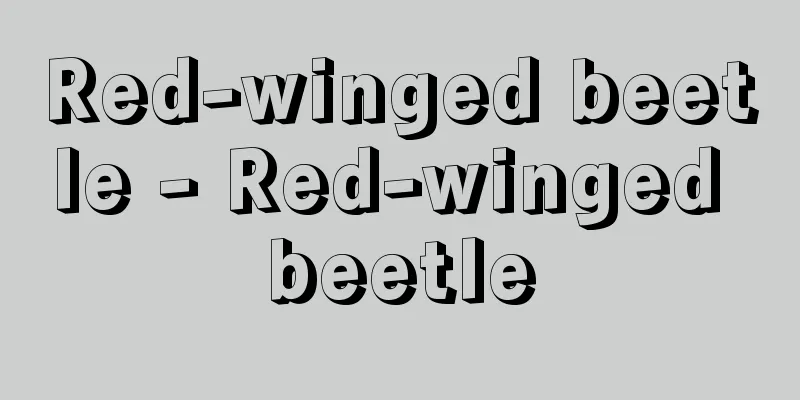Shaft coupling - joint

|
A mechanical part that directly connects two shafts to transmit rotation and power. It is also called a coupling. A coupling that semi-permanently fixes the connection between two shafts is called a fixed shaft coupling, while a coupling that allows a certain degree of movement between the two shafts is called a flexible shaft coupling. [Hidetaro Nakayama] Fixed Shaft CouplingTwo shafts are butted together, a cylindrical metal fitting is placed over the joint, and a key is driven into each shaft to secure them. This type is generally used when the shaft diameter is small, and is called a tubular joint (muff joint). A special type of tubular joint is the cellar joint. The inside of the sleeve is slightly tapered from both ends, and an inner sleeve with a tapered outside is fitted face to face with this, and then bolted together. Flange joints are used for shafts with large diameters. This is the most commonly used type, in which a cast iron flange is attached to the end of the shaft with a key, and the flange is tightened with several bolts to join them. When joining large diameter shafts, such as ship propeller shafts, the flange is made integral with the shaft during forging, and the flange is tightened with bolts to join them. Because it is integral, the flange can be small in diameter and light. [Hidetaro Nakayama] Flexible Shaft CouplingThis is used to connect two shafts when it is difficult to align their center lines correctly. It is also used when fixing two shafts together is problematic due to temperature changes. An elastic material such as leather or rubber is placed between the bolts of the flange joint, allowing the shafts to bend slightly, and is also called a flexible joint. [Hidetaro Nakayama] Universal jointThis is used when two shafts are on the same plane and their centerlines intersect at an angle. The ends of the two shafts are forked and connected with a cross-shaped pin. The angle between the two shafts can be changed. However, it has the disadvantage that when one shaft rotates at a constant speed, the other shaft does not rotate at a constant speed. If you want to keep the rotation speed of two shafts constant, you use two of these universal joints. That is, an intermediate shaft is placed between the two shafts and a universal joint is used on both ends. If the angle between the driving shaft and the intermediate shaft and the angle between the driven shaft and the intermediate shaft are made equal, the constant rotation of the driving shaft is transmitted to the driven shaft, and the driven shaft also rotates at a constant speed. There is also a type of constant velocity universal joint that can make the driving shaft and the driven shaft rotate at the same speed without using an intermediate shaft, and it is widely used in automobiles. None of the above couplings can interrupt the rotation between the two shafts while they are in motion. One type of shaft coupling that can connect and disconnect motion is a dog clutch. A flange with pawls is fitted to the end of the shaft, and motion is connected and disconnected by disengaging and connecting the pawls. Another type of shaft coupling is a friction clutch, which transmits motion between two shafts by bringing friction plates attached to the ends of the shafts into contact and releasing them. A fluid clutch, in which vanes are attached to the ends of two shafts and placed in a container filled with oil to transmit power via fluid, is also a type of shaft coupling. [Hidetaro Nakayama and Shinji Shimizu] [Reference item] | |©Shogakukan "> Main types of shaft couplings Source: Shogakukan Encyclopedia Nipponica About Encyclopedia Nipponica Information | Legend |
|
二つの軸を直接連結し回転や動力を伝えるようにする機械部品。カップリングcouplingともいう。2軸の連結を半永久的に固定してしまうものを固定軸継手といい、2軸の間にある程度の移動ができるようにしたものを、たわみ軸継手という。 [中山秀太郎] 固定軸継手2軸を突き合わせその継ぎ合わせ部に筒形の金物をかぶせ、それぞれの軸にキーを打って止めたもので、一般に軸径の小さいときに用いられ、筒形継手(マフ継手)という。筒形継手の特別なものとしてセラー継手というものがある。スリーブの内側が両口からわずかの傾斜をつけたテーパーとなり、これに外側がテーパーとなっている内スリーブを向き合わせてはめ、ボルトで締め寄せたものである。軸径の大きいものにはフランジ継手が用いられる。もっともよく用いられるもので、鋳鉄製のフランジ(つば)を軸の端にキーで止め、数個のボルトでフランジを締め寄せて結合する。船の推進軸のように径の大きい軸を結合するときには、鍛造のときフランジを軸と一体につくりだし、ボルトでフランジ部を締めて結合する。一体であるためフランジ部は径は小さく、しかも軽くてすむ。 [中山秀太郎] たわみ軸継手2軸の中心線を正しく一致させるのが困難であるとき、この軸を結合するのに使用されるもの。また温度の変化により、2軸を固定してしまっては困るようなときにも使用される。フランジ継手のボルトの部分に皮あるいはゴムのような弾性体を介在させ、軸が多少たわんでもよいようにしてあり、たわみ継手ともいう。 [中山秀太郎] 自在継手2軸が同一平面上にあって、その中心線がある角度で交わるときに用いられるもの。2軸の端を二またとし、それらを十字形のピンで連結した構造をもっている。2軸のなす角は変えることができる。しかし、一方の軸が一定速度で回転しているとき、他方の軸は一定速度では回転しない欠点がある。2軸の回転速度を一定にしたいときは、この自在継手を2個使用する。すなわち2軸の間に中間軸を入れ、その両端に自在継手を使用する。原動軸と中間軸とのなす角と、従動軸と中間軸とのなす角を等しくすれば、原動軸の一定回転は従動軸に伝えられ、従動軸も一定回転をする。このような中間軸を介さなくても、原動軸と従動軸を同じ速度にできる等速自在継手というものもあり、自動車などで広く使用されている。 以上の軸継手はいずれも運動中に2軸間の回転を断続させることはできない。 運動を断続させられる軸継手としては、かみ合いクラッチがある。つめをもったフランジを軸端にはめ、つめのかみ合いを切ったりつないだりして運動を断続する。また軸の端に取り付けた摩擦板を接触させたり離したりして、2軸間に運動を伝えるものは摩擦クラッチという。2軸の端に羽根を取り付け、油を満たした容器内に入れ、流体を介して動力を伝達する流体クラッチも、軸継手の一種である。 [中山秀太郎・清水伸二] [参照項目] | |©Shogakukan"> 軸継手のおもな種類 出典 小学館 日本大百科全書(ニッポニカ)日本大百科全書(ニッポニカ)について 情報 | 凡例 |
<<: Zhu Dao Sheng (English: Zhu Dao Sheng)
>>: Local currency - Jiguchisen
Recommend
Booklice (tea stick insect) - Booklice (English spelling) barklice
A general term for insects belonging to the order ...
Avatamsaka Sutra - Kegonkyo
A Buddhist scripture. More specifically, the Grea...
Donation Association - Kifukaishi
…These are bills used by the general public durin...
Stroessner, Alfredo
Born: November 3, 1912, Encarnacion, Paraguay [Die...
Tuberous root
...Cyclamen, Caladium, Gloxinia, Anemone, etc. (4...
Hypatia
A female philosopher and naturalist from ancient A...
dietitian
... In medical institutions, dietary therapy is c...
Ichikawa Sanki
English scholar. Great-grandson of the late Edo p...
micturition
…In this way, the kidneys finally produce urine w...
Alp Arslān
1029‐72 The second Sultan of the Seljuk Empire. Re...
Collection of works by the regent Ichijo - Ichijo Sessho Gyoshu
This is a private collection of poems by Fujiwara...
Burn shock death - kashoshokushi
...Toxic shock death occurs when a person is pois...
Jurist
...Even during the Cold War, the desire to emigra...
Juan de Garay (English spelling) JuandeGaray
… The city was founded in 1536 by the Spaniard Pe...
Frederikshavn - Frederikshavn (English spelling)
A port city on the Kattegat Strait in the northern...









